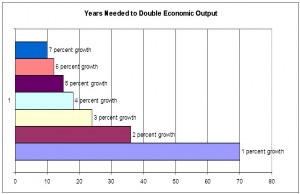In prior posts, I’ve shared some remarkable numbers on the cost of regulation.
- Americans spend 8.8 billion hours every year filling out government forms.
- The economy-wide cost of regulation is now $1.75 trillion.
- For every bureaucrat at a regulatory agency, 100 jobs are destroyed in the economy’s productive sector.
But the long-run damage may be even worse than any of us suspected. Here are some details about a new study, as digested by Reason’s science expert.
The growth of federal regulations over the past six decades has cut U.S. economic growth by an average of 2 percentage points per year, according to a new study in the Journal of Economic Growth. As a result, the average American household receives about $277,000 less annually than it would have gotten in the absence of six decades of accumulated regulations—a median household income of $330,000 instead of the $53,000 we get now. The researchers, economists John Dawson of Appalachian State University and John Seater of North Carolina State, constructed an index of federal regulations by tracking the growth in the number of pages in the Code of Federal Regulations since 1949. …They devise a pretty standard endogenous growth theory model and then insert their regulatory burden index to calculate how federal regulations have affected economic growth. …Annual output in 2005, they conclude, “is 28 percent of what it would have been had regulation remained at its 1949 level.” The proliferation of federal regulations especially affects the rate of improvement in total factor productivity, a measure of technological dynamism and increasing efficiency. …Overall, they calculate, if regulation had remained at the same level as in 1949, current GDP would have been $53.9 trillion instead of $15.1 in 2011. In other words, current U.S. GDP in 2011 was $38.8 trillion less than it might have been.
That sounds unbelievable, even to a red-tape critic like me.
And the author of the column also is a bit skeptical. But even when he plays with the numbers a bit, he still finds that the cost of regulation is enormous.
…let’s say that the two economists have grossly overestimated how fast the economy could have grown in the absence of proliferating regulations. So instead let’s take the real average GDP growth rate between 1870 and 1900, before the Progressives jumpstarted the regulatory state. Economic growth in the last decades of the 19th century averaged 4.5 percent per year. Compounding that growth rate from the real 1949 GDP of $1.8 trillion to now would have yielded a total GDP in 2013 of around $31 trillion. Considerably lower than the $54 trillion estimated by Dawson and Seater, but nevertheless about double the size of our current GDP. All this means that the opportunity costs of regulation—that is, the benefits that could have been gained if an alternative course of action had been pursued—are much higher than the costs of compliance.
The key thing to understand is that faster economic growth, if maintained for a long period, can yield huge increases in living standards thank to compounding.
 The accompanying chart, for instance, shows that it takes 70 years for a country to double economic output if it suffers with Italian-style 1 percent annual growth.
The accompanying chart, for instance, shows that it takes 70 years for a country to double economic output if it suffers with Italian-style 1 percent annual growth.
But if a nation enjoys rapid annual growth, it’s possible to double GDP in 10-20 years.
The moral of the story, needless to say, is that we should have less regulation…as well as less spending, lower taxes, more trade, etc.

